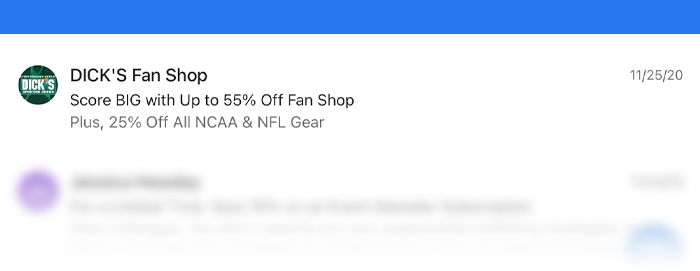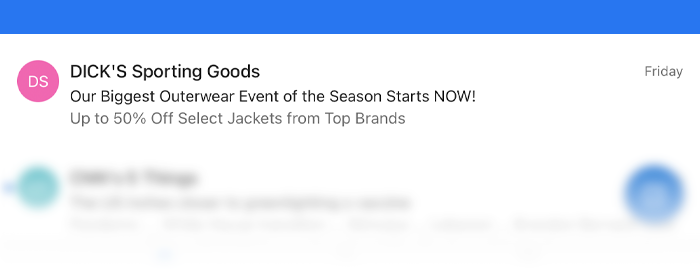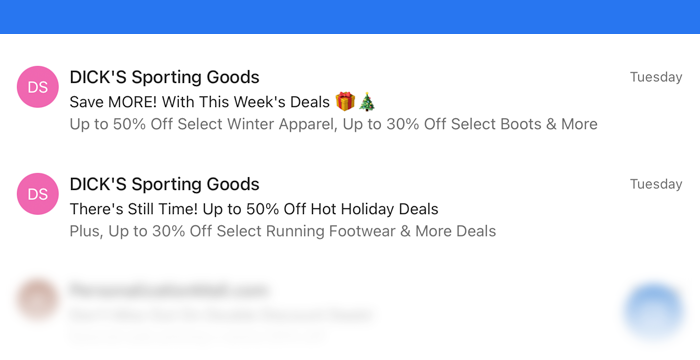
Advertising legend David Ogilvy once said, “Five times as many people read the headline as read the body copy. When you have written your headline, you have spent eighty cents out of your dollar.”
Like a headline for a blog post or news article, the subject line for your email needs to capture people’s attention and convince them to open your message. A subject line can make or break the performance of your email, so it’s important to spend extra time crafting one that’s memorable and effective.
Good subject lines get to the point, create a sense of urgency and are relevant to the subscriber, but it’s easy to make mistakes when writing them.
Committing these subject line sins can drastically reduce your open rates, but avoiding them is easy if you know what to look for.
Here are six of the most common mistakes people make when writing email subject lines, as well as tips to improve them and boost your open rates.
1. Using ALL CAPS
Imagine receiving an email with a subject line like this in your inbox: GET 40% OFF YOUR NEXT PURCHASE RIGHT NOW
Chances are you would take one of three actions: ignore it, delete it, or mark it as spam.
Before pressing send, keep in mind that USING EXCESSIVE CAPITALIZATION CAN SCARE AWAY SUBSCRIBERS AND KILL YOUR OPEN RATES. It can come across as though you are yelling, which can have a negative impact on your email performance. So you should use caps in subject lines very carefully.
Do this instead:
Using caps in an email can be effective if you use it on a single word in a subject line. But it also needs to be the right word.
Dick’s Sporting Goods does a good job subtly calling out “MORE”, “BIG” and “NOW” in the subject line examples below.



Related: Your Guide to Writing the World’s Best Email Subject Lines
2. Using too much punctuation!!!!
Taking the example we used earlier, imagine we added punctuations - a lot of them: GET 40% OFF YOUR NEXT PURCHASE RIGHT NOW!!!!!!!!!!!!!!!!!!!
You have limited real estate for your subject line, and multiple exclamation marks can come across as spammy. Special characters such as * % & # and ^, have been known to trigger spam filters, so be sure to use them sparingly as well.
Do this instead:
Now that we’ve gone over the punctuation mistakes to avoid in your subject line, you may be wondering which characters lead to more open rates.
The answer? Question marks, exclamation points and periods.
According to Touchstone, 2-4% of email subject lines end with a full stop or a period. They also found that subject lines with exclamation points can expect an open rate 1-20% higher than average – just as long as they’re not used in every message.
While this can vary depending on your industry, your audience, and the content of your messages, test multiple subject lines to see which forms of punctuation your subscribers respond to.
Here’s an example of a subject line from Enchanting Marketing:

By using simple language, asking a question, and using proper punctuation in her subject line, founder Henneke Duistermaat piques the reader’s interest and entices them to read the message.
Exclamation points, periods, and question marks are all part of a healthy email marketing strategy, so don’t be afraid to mix up the punctuation you use in your subject lines.
3. Using Spammy Words
Adding certain trigger words to your subject line can activate a recipient’s spam filter, even if the message you’re sending is legitimate.
To prevent this from happening, avoid certain words, phrases, and symbols like “$$$,” “100% free,” “cash off,” “cheap,” “weight loss,” and “serious cash.” Even if your email makes it into the inbox, it can come across as spammy to your subscribers.
Do this instead:
To ensure your readers take your emails seriously, choose the language in your subject line carefully by avoiding some of the trigger words and symbols listed above.
Finding the right verbiage for your subject line can be tough, especially with the sophisticated spam filters out today. What works for one industry may not work for another. Be sure to try different variations of words to see what resonates best.
I also recommend focusing on specific words that tie back to the content in your email. Check out this example from our friends at Social Media Examiner:

The subject line tells you exactly what you’ll get by opening up the email. And by focusing on that, it eliminates the risk of including words that might appear spammy.
Bonus Tips: Occasionally adding phrases like “Free” or “Act Now” have been shown to improve open rates, but I recommend using them sparingly to avoid diluting their impact.
4. Making It Too Long
Consider the environment in which your subscribers are reading your emails. Chances are, they’re on-the-go or quickly scanning their inboxes between work meetings.
Since you have only seconds to capture their attention, you want to make sure your subject lines aren’t wordy or redundant.
Long subject lines look spammy and get lost in cluttered inboxes, especially if readers are using mobile devices.
Do this instead:
Aim to get your message across as quickly as possible and cut any unnecessary terms or phrases. Our AWeber team of email experts analyzed the top marketers’ emails and found their email subject line averaged slightly under 44 characters.
As important as it is to get your message across quickly and clearly, make sure it expresses a complete thought and offers value to the reader – you don’t want to write a subject line that’s too short, either. Avoid one-word subject lines and strive to be helpful and relevant to your subscriber.
Professional photography blogger Courtney Slazinik conveys her message concisely with the following subject line:

By building a message around a numbered list and including the word “secrets,” Courtney offers value and creates a sense of mystery around her content. As a result, this subject line is easily skimmable and irresistibly clickable.
Related: Get Higher Open Rates with 22 of the Best Email Subject Lines
5. Writing misleading content
Let’s say you send an email with the following subject: Get an exclusive 50% discount on our entire inventory!
But when the reader opens the email, it’s a pitch to sign up for a webinar or free online class.
Not only is this tactic dishonest, it also tends to backfire. No one likes to be deceived, especially when they receive an email that promises one thing and delivers another. You might get people to open your email initially, but this alienates subscribers and can hurt your open rates and spam rates in the long run. If your subscribers lose trust in your emails, they’re more inclined to ignore future emails and mark you as spam.
To build and maintain trust between you and your subscriber, make sure to align the content of your email and your subject line.
This also applies to emails that include RE: or FW:. These tend to trick the reader into thinking the email was part of another conversation, which doesn’t leave a positive feeling with subscribers.
Not including this text also gives you more room to work with in your subject line, which can be used to convey helpful and relevant information instead.
Related: The Secret to Writing Addictive Email Content
6. Including spelling or grammar errors
Subject lines (or any other content in your email) with typos, misspelled words, and misplaced punctuation look unprofessional and can hurt your open rates.
Emails are an opportunity to establish your brand as a helpful source of information. Subject lines with spelling or syntax errors make a bad first impression, and undermine your ability to establish trust with your subscribers.
Do this instead:
To optimize your email open rates, be sure to review your emails for grammar and spelling prior to hitting send. No one will take the time to read your email if the subject line is loaded with grammar mistakes, but basic copy editing can prevent these errors from slipping through the cracks.
Related: 3 Ways to Test Your Emails before Hitting ‘Send’
Crafting subject lines that sweep subscribers off their feet
The subject line is one of email’s most important components, so it’s essential to get it right before you send your emails. And by avoiding the mistakes above, you’ll be well on your way towards improving your email engagement.
Related: Email Authentication: A Powerful Way to Help Get your Emails into the Inbox
Ready to use these tips to write better subject lines? Sign up for AWeber Free today to start writing amazing subject lines.
The post The 6 Most Common Subject Line Mistakes to Avoid appeared first on AWeber.
from AWeber https://ift.tt/2fC5m0L
via IFTTT
No comments:
Post a Comment